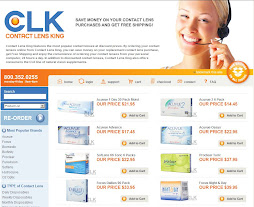The use of home and office computers has become so prevalent in just the last generation that we find it hard to believe how we ever got along without them. While they have been a definite boon to our quality of life and work, they have also handed us a whole new hurdle when it comes to eye care.
An outgrowth of extended computer use has been what the doctors term Computer Vision Syndrome (CVS), an increasingly common occurrence defined by tired or burning dry eyes and headaches caused by the strain of focusing on the screen over long periods of time. The eyes work differently when viewing a computer screen as opposed to regular day-to-day vision requirements. Constant and focused concentration on the computer screen changes the rate of blinking, which leads to dryer eye tissues. As a consequence the contact lens wearer focused on a computer screen will feel that their lenses are drying faster and causing some level of discomfort, or even perhaps poorer vision quality.
Just like other industries that have provided other types of long-term solutions for computer workers, the optical industry has made its own contributions. As an example, there is eyewear available with specialized lenses that work to reduce glare and assist users in enjoying a more comfortable visual experience at the computer. The contact lens industry proposed silicone hydrogel lenses, made of a new material that binds less water than the older polymers with higher water content. These may also have specialized wetting agents bound to their surface or incorporated into their polymer matrix in order to preserve the desired hydration for longer periods—even in difficult situations. Silicone hydrogel lenses also provide the highest oxygenation levels in the industry and remain moist. In fact, these lenses transmit oxygen an average of six times more than prior lenses, allowing for optimum eye and cornea health.
For those entering the world of presbyopia (the decreased accommodation at different fields of vision that usually occurs after the age of 40), multifocal contact lenses provide a progression of corrective powers from far, intermediate to near vision. This smooth flow of vision while working at the computer is less jarring than the effect of bifocals, which can leave you bobbing your head up and down adjusting to the abrupt change from far to near lens power. By having an intermediate range, multifocals allow you to keep your head in one position while your eyes scan the screen through the mid and near portions of your lens.
Your eye doctor can diagnose for CVS and help you choose a contact lens that can compliment your computer work. Once you have a valid lens prescription, an online retailer can easily be found who will provide you with a money-saving and convenient avenue for purchasing your contact lenses.
With the kinds of innovations seen in the contact lens industry through each passing year, efforts shall continue to yield improvements that will give eager lens wearers the best possible contact lens for easing and enhancing our hours at the computer.
Friday, August 13, 2010
Computers and Contact Lenses
Subscribe to:
Post Comments (Atom)





No comments:
Post a Comment